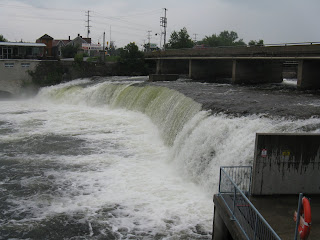
From our last anchorage in a quiet spot at the Bustard Islands we moved over to Bad River, passing a Canadian Coast Guard vessel working on channel marker buoys. We went up river to a cove and prepared to anchor among 7-8 other boats. About that time a dinghy came up with a fellow on board who suggested that we come tie up next to him on his 34 foot American Tug. This fellow we got to know was Randy Guzar and he and his wife Audrey were the well known American Tug experts for Georgian Bay. (Dick & Nancy White, on Emerald Lady At-41, said that they had told Randy to watch for us.) Randy and some other boaters helped us get tied up against the rock wall pictured. It was fairly vertical wall and we were tied to roots and even one railroad spike that another boater provided for us. It was a great spot and I was able to take a swim every afternoon there.

A couple hours after we tied up Randy came over and asked if we wanted to take a dinghy ride. We decided to take both dinghys so the wives could go too. Randy instructed us how to negotiate the many rapids that were near by. Most of the rapids were strong with a stream 1 - 2 feet high shooting through between large rocks. They didn't look deep enough but with a good head of steam and on plane we were able to jump up through them and also come back down. The first rapid you go through from the anchorage on Bad River even has a name on the charts - Devil Door Rapids. This picture shows Randy and Audrey showing us the way.

Without a guide I would have never attempted these rapids. The Bad River is really part of the French River which was explored by Champlain in 1615. The French River comes from the East and splits into several rivers or channels. One is the French River Western Channel which branches and one branch is the Bad River Channel, usually just called Bad River. North of this area Champlain noted was an area where the Indians came to pick and dry blueberries and raspberries.

The first night we were there Randy had invited all the boaters in the cove to a happy hour on the rocks above his boat. We joined them and had snacks with boaters from various parts of Canada as well as New Jersey and Michigan.
The next day I took the dinghy out by myself to re-investigate the Bad River and the rapids.
There were many different paths and interesting rock formations everywhere. It was fun to traverse the rapids, but when I came to ones I had not been on, I had a good time just heading the bow close in to the flow and matching engine power to the force of the water to try to maintain the dinghy in one spot for as long as possible before the surging water would push me to one side or the other.

This is an example of one of the boats that went down the rapids. We also saw many canoeist who were probably on fishing expeditions.

From the area just above our boat there was excellent blueberry picking. I asked another boater where the good spots were and what to look for. He took me back 50 yards or so to several spots. He thought that most were under pine trees in wetter shaded areas. Any way I found a good supply and picked 3/4 pint in a short time. The blueberries on on low plants almost like ground bushes. They are much smaller than the ones we buy at the store, or else someone else got the big ones first. The picture is of a blueberry plant with a boat hook that I used to feel around for rattle snakes since signs said they were present in this area.

We stayed two nights at Bad River and could have stayed longer. Just after we left out cove to head out the river to Georgian Bay we say this animal swimming across the channel. I called Kaye and told her there was a beaver in front of us. I assume it was a beaver since we saw one during the happy hour the first night. As we got closer I realized it was a bear. (I'm not sure the difference between black bears and brown bears but this one had a black coat.) I slowed the boat to not hit him or scare him and watched as he reached shore, bounded up the side, turned to look at us menacingly, and took off into the woods. It was a neat experience.












































